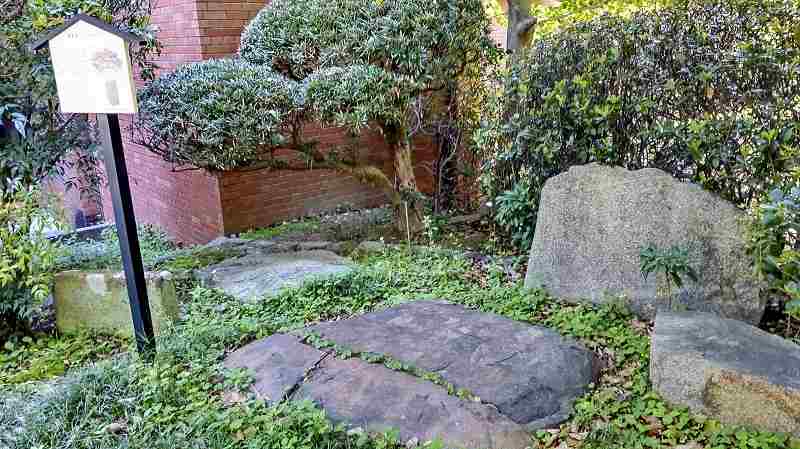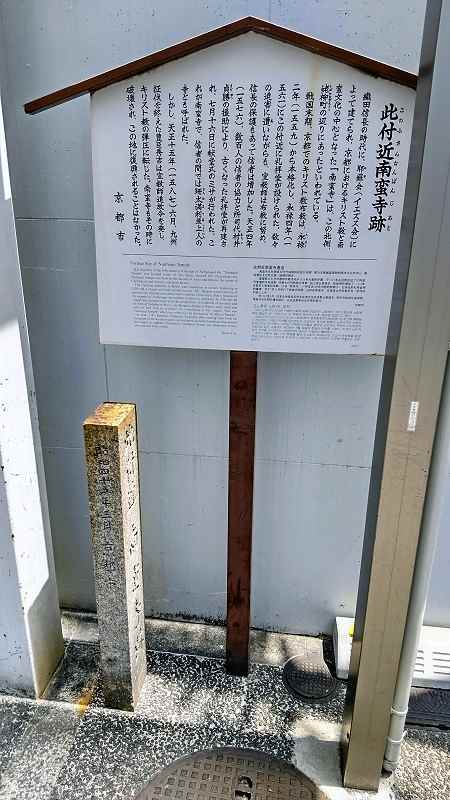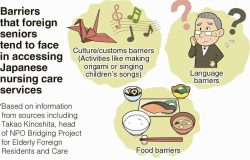
A foundation stone excavated from the Nanbanji church site is displayed on the Imadegawa campus of Doshisha University in Kamigyo Ward, Kyoto.
11:39 JST, June 16, 2022
Starting in the 16th century, those who arrived in Japan from Portugal, Spain and other Western countries were referred to as “nanbanjin,” meaning “barbarians from the south.” Why the south? This was derived from the fact that their voyage to Japan came via Southeast Asia.
The Japanese at that time followed Chinese practice and generally labeled tribes from distant places and people from overseas as “banjin” (barbarian). As the ancient Greeks and Romans also referred to the Germanic people as barbarians, it is not so unusual in world history.
On a side note, the Dutch arrived in Japan later. Although they were regarded as Westerners, they were called “komojin” (red-haired people) based on the distinctive color of their hair.
While both “nanbanjin” and “komojin” were certainly derogatory terms, they did not mean that the foreigners were looked down upon as uncivilized. They were not looked up to, either. The locals were simply extremely intrigued by their unusual customs and possessions, a curiosity that can be seen in the many “nanban byobu” — folded screen paintings of the “barbarians” — that were created.
Two things that the visitors brought with them had a profound impact on Japanese history — guns and Christianity.
Guns altered the way wars were fought in Japan. The daimyo lord Oda Nobunaga made the most effective use of guns to become ruler of Japan. And while Nobunaga never converted to Christianity himself, he greatly used the religion for his own ends. It allowed him to neutralize Buddhist power in places in the country where it had a fighting capability equivalent to a daimyo.
Christianity was first brought to Japan by Francis Xavier, a Basque missionary from the Kingdom of Navarre in Spain and a founding member of the Society of Jesus, also known as the Jesuits.
Xavier arrived in Kyoto, the then capital of Japan, in 1550. As governance by the Muromachi shogunate was unstable at the time, he was not able to engage in missionary work there.
Afterward, Nobunaga took Kyoto by force and accommodated the missionaries who succeeded Xavier by allowing them to pursue their mission.

A stone monument at the former site of Nanbanji in Nakagyo Ward, Kyoto, with an explanatory board for the church
In 1576, with Nobunaga’s permission, the Jesuits built a church in Kyoto’s Ubayanagi district. The church was named the “Church of the Assumption of Mary;” the Japanese, however, dubbed it “Nanbanji” (“ji” means temple). The building was a three-story wooden structure that resembled a Japanese castle.
It did not last long. Nobunaga’s successor Toyotomi Hideyoshi issued a decree in 1587 expelling missionaries from Japan, and the church disappeared from history. It is believed to have been destroyed.
The subsequent Edo shogunate went further and issued a ban on Christianity, resulting in the loss of most early traces of the religion in Japan.
Today, only a small stone monument stands on the site where the Nanbanji church was located. Excavation work conducted in the 1970s by Doshisha University confirmed that it was the site of the church. An unearthed foundation stone and other items have since been on display at the university in Kamigyo Ward.
In addition, there is an ancient bell that is believed to be associated with Nanbanji currently in the possession of Shunko-in, a sub-temple of the Myoshinji temple in Ukyo Ward. Although temple records state that the bell, about 60 centimeters tall, came from Korea, it is inscribed with the emblem of the Society of Jesus.
This includes the monogram IHS, which are the first letters of Jesus in Latin but is also said to be the Latin initials for “Jesus, Savior of Men.” The bell also bears the number “1577” in Arabic numerals, instead of the kanji characters used by Japanese.
That date is one year after the church was built.
"JN Specialities" POPULAR ARTICLE
-

The Japan News / Weekly Edition (12/12-12/18)
-

Noodle Dining Shunsai / Rich Oyster Ramen to Savor at Odasaga; Experienced 68-year-old Owner Creates Numerous Ramen Varieties
-

The Japan News / Weekly Edition (12/5-12/11)
-

People Keep Loved Ones’ Ashes Close in Special Jewelry, Small Urns as Unique Way to Memorialize Them
-

The Japan News / Weekly Edition (12/19-12/25)
JN ACCESS RANKING
-

Tokyo Economic Security Forum to Hold Inaugural Meeting Amid Tense Global Environment
-

Keidanren Chairman Yoshinobu Tsutsui Visits Kashiwazaki-Kariwa Nuclear Power Plant; Inspects New Emergency Safety System
-

Imports of Rare Earths from China Facing Delays, May Be Caused by Deterioration of Japan-China Relations
-

University of Tokyo Professor Discusses Japanese Economic Security in Interview Ahead of Forum
-

Japan Pulls out of Vietnam Nuclear Project, Complicating Hanoi’s Power Plans

























